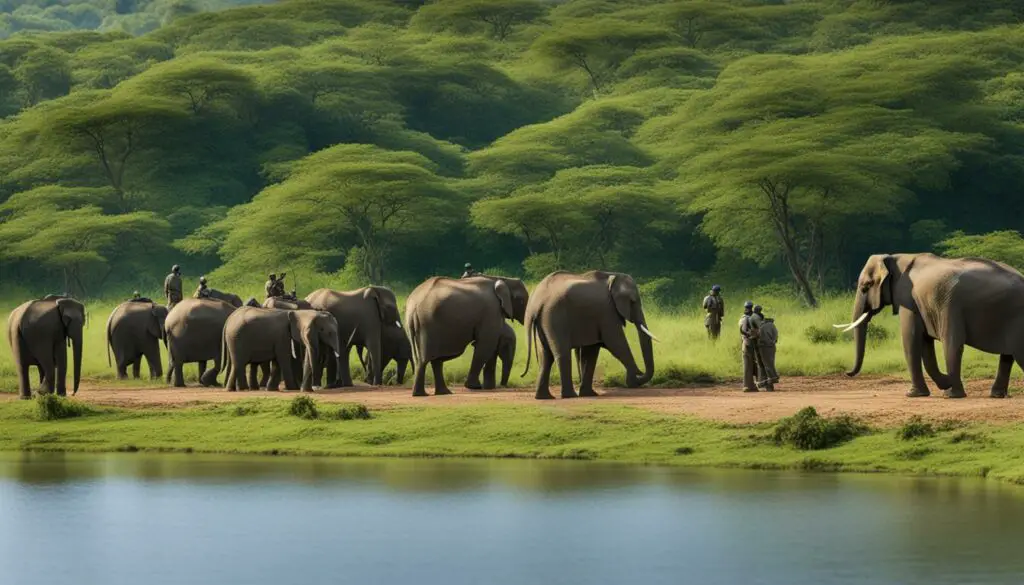Elephant conservation success stories and successful elephant conservation projects have demonstrated effective strategies and positive outcomes in preserving these majestic animals. Over the last three decades, elephant populations in Africa and Asia have faced challenges such as habitat destruction and illegal wildlife trafficking. However, initiatives from AZA-accredited zoos, international organizations, and national parks have made significant contributions to the conservation of elephants and their habitats.
From providing financial support and protection for elephants in the wild to implementing anti-poaching measures and international cooperation, these efforts have yielded inspiring results. AZA-accredited zoos, for example, have not only prioritized animal care and management but also contributed millions of dollars towards protecting elephants in their natural habitats. The collaboration of international organizations, such as CITES and the IUCN, along with strict conservation measures and sustainable alternatives to ivory, further strengthens the preservation of elephant populations.
One notable success story is Kaziranga National Park in India, where the population of one-horned rhinos has seen a remarkable increase due to rigorous conservation efforts. The park’s strong anti-poaching measures and focus on rhino protection have not only benefited these key species but also contributed to the preservation of elephant populations and their ecosystems.
While challenges like poaching and human-elephant conflicts persist, the achievements in elephant conservation emphasize the importance of ongoing efforts to protect and ensure the survival of these magnificent creatures for future generations. Let us be inspired by these success stories and continue to strive for a better future for elephants through conservation and environmental stewardship.
AZA-accredited zoos’ contribution to elephant conservation
AZA-accredited zoos have played a significant role in the successful conservation of elephants. These zoos prioritize animal care and management based on high standards and humane practices. In addition to providing a safe and enriched environment for elephants under their care, AZA-accredited zoos have also made substantial financial contributions to protect elephants in the wild.
Between 2015 and 2019, these zoos contributed over $16.5 million to support initiatives focused on the conservation of elephants. One such initiative is the Elephant Protection Initiative (EPI), which aims to secure landscapes for elephants, reduce poaching, and combat the illegal ivory trade. AZA-accredited zoos have also partnered with the International Elephant Foundation, a nonprofit organization that funds and supports elephant conservation projects around the world.
| Year | Amount contributed ($) |
|---|---|
| 2015 | 3,500,000 |
| 2016 | 4,200,000 |
| 2017 | 3,800,000 |
| 2018 | 2,900,000 |
| 2019 | 2,100,000 |
These financial contributions demonstrate the commitment of AZA-accredited zoos to the conservation of elephants and their habitats. By supporting various projects and organizations, they actively contribute to the protection and preservation of these magnificent creatures, ensuring their survival for future generations.
Protecting Asian Elephant Projects
AZA-accredited zoos have also dedicated funds specifically for Asian elephant conservation through AZA SAFE: Saving Animals From Extinction. This initiative focuses on cooperative conservation programs to save endangered species, including the Asian elephant. By implementing effective strategies and collaborating with partners globally, AZA-accredited zoos are actively engaged in efforts to protect and conserve Asian elephants and their habitats.
International efforts and conservation measures for elephants
Protecting elephants from extinction requires collaborative efforts on a global scale. International organizations have been instrumental in implementing conservation measures to safeguard these magnificent creatures and their habitats. The Convention on International Trade in Endangered Species of Wild Fauna and Flora (CITES) is a crucial regulatory body that aims to prevent the illegal trade of wildlife, including elephants.
The African Elephant Conservation Act and the Asian Elephant Conservation Act, enacted in the United States, play a vital role in supporting elephant preservation efforts. These legislations provide financial assistance and implement strict measures against the importation of illegal ivory. Additionally, the International Union for Conservation of Nature (IUCN) and the Endangered Species Act contribute to the protection and recovery of elephant populations.
Anti-poaching patrols have proven to be effective in deterring illegal hunting activities and protecting elephants from harm. By collaborating with local communities and law enforcement agencies, these patrols actively work towards combating the illegal ivory trade. Furthermore, sustainable alternatives to ivory products, such as elephant-friendly tourism and community-based conservation initiatives, serve as long-term solutions to mitigate human-elephant conflicts and promote the coexistence of these majestic animals with local communities.
The Impacts of International Efforts
“Thanks to the combined efforts of international organizations and conservation initiatives, significant progress has been made in elephant conservation. Through strict regulations, anti-poaching patrols, and sustainable approaches, we are safeguarding these incredible creatures and preserving the biodiversity of our planet. Together, we can ensure a future where elephants thrive and continue to inspire generations to come.”
The achievements in elephant conservation are a testament to the dedication and collaboration of governments, organizations, and individuals worldwide. By focusing on international cooperation, strict regulations, and community engagement, we have made significant strides in saving elephants from extinction. However, continued efforts and support are essential to address the remaining challenges and secure a sustainable future for these iconic animals.

| Conservation Measure | Impact |
|---|---|
| International Cooperation | Facilitates information sharing, joint initiatives, and coordinated efforts to combat illegal wildlife trafficking and protect elephant populations. |
| Regulatory Frameworks | Legislations such as CITES, the African Elephant Conservation Act, and the Asian Elephant Conservation Act provide legal mechanisms to regulate and control the trade of ivory and elephant products. |
| Anti-Poaching Patrols | Active patrols and law enforcement efforts deter poaching activities and protect elephants from being killed for their ivory. |
| Sustainable Solutions | Promoting elephant-friendly tourism and community-based conservation initiatives lessen human-elephant conflicts and support the well-being of both elephants and local communities. |
Inspiring Stories of Elephant Conservation
When it comes to successful elephant conservation efforts, the story of Kaziranga National Park in India stands out as an inspiring example. This park, known for its population of one-horned rhinos, has seen remarkable outcomes in preserving not just rhinos but also elephants and other wildlife. The success of Kaziranga can be attributed to its strong anti-poaching measures and dedicated protection force, which is authorized to shoot alleged poachers on sight. These rigorous efforts have contributed to a significant increase in the rhino population, from a mere dozen in 1905 to an estimated 2,613 in Kaziranga alone.
But the positive outcomes extend beyond rhinos. Kaziranga National Park also boasts the highest density of tigers in the world. The focus on rhino protection has indirectly benefited other species, including elephants, by creating a safer and more secure ecosystem. The park’s conservation efforts serve as a testament to the effectiveness of dedicated anti-poaching measures and strict enforcement of wildlife protection laws.
To summarize the conservation success in Kaziranga National Park:
| Positive Outcomes | Details |
|---|---|
| Increase in Rhino Population | From a dozen to an estimated 2,613 in Kaziranga alone |
| High Tiger Density | Highest tiger density in the world |
| Effectiveness of Anti-Poaching Measures | Protection force authorized to shoot alleged poachers on sight |
These accomplishments in Kaziranga National Park highlight the importance of robust conservation efforts in preserving elephant populations and their ecosystems. By employing strict anti-poaching measures and promoting habitat protection, we can achieve positive outcomes and inspire further conservation initiatives around the world.
Preserving Elephants for Generations to Come
The success of Kaziranga National Park serves as a reminder that with dedicated efforts and a commitment to wildlife protection, we can make a difference in preserving elephants and other endangered species. By learning from inspiring stories like those of Kaziranga, we can develop effective strategies that prioritize anti-poaching measures, habitat preservation, and international cooperation in the fight against illegal wildlife trafficking.
It is crucial that we continue to support and advocate for elephant conservation initiatives globally. Through education, raising awareness, and supporting organizations dedicated to the protection of elephants, we can ensure a brighter future for these magnificent creatures and create a world where they can thrive for generations to come.
Conclusion
Elephant conservation has witnessed remarkable success through the collaborative efforts of various stakeholders. AZA-accredited zoos, international organizations, and national parks like Kaziranga have made significant contributions to the preservation of these magnificent creatures and their habitats.
These successful elephant conservation projects have implemented effective strategies to ensure the survival of elephant populations. Financial support from AZA-accredited zoos has provided crucial resources for conservation initiatives, while anti-poaching measures and international cooperation have played vital roles in protecting elephants from illegal wildlife trafficking.
Despite the ongoing challenges of poaching and human-elephant conflicts, the dedicated efforts of these projects demonstrate the importance of continued conservation to secure a better future for elephants. By fostering a sense of environmental stewardship and engaging local communities, we can further strengthen conservation efforts and create a sustainable coexistence between humans and elephants.
What Measures Can Be Taken to Combat Elephant Poaching and Ensure Conservation Success?
Elephant poaching has devastating effects on elephant populations worldwide. To combat this issue and ensure conservation success, several measures can be taken. Strengthening anti-poaching efforts, implementing stricter legal frameworks, and raising public awareness about the impact of poaching on elephant populations are crucial steps. Additionally, promoting community involvement, supporting conservation organizations, and encouraging sustainable tourism can contribute to the overall protection and preservation of these majestic creatures.
| Conservation Measure | Impact |
|---|---|
| International Cooperation | Facilitates information sharing, joint initiatives, and coordinated efforts to combat illegal wildlife trafficking and protect elephant populations. |
| Regulatory Frameworks | Legislations such as CITES, the African Elephant Conservation Act, and the Asian Elephant Conservation Act provide legal mechanisms to regulate and control the trade of ivory and elephant products. |
| Anti-Poaching Patrols | Active patrols and law enforcement efforts deter poaching activities and protect elephants from being killed for their ivory. |
| Sustainable Solutions | Promoting elephant-friendly tourism and community-based conservation initiatives lessen human-elephant conflicts and support the well-being of both elephants and local communities. |
Inspiring Stories of Elephant Conservation
When it comes to successful elephant conservation efforts, the story of Kaziranga National Park in India stands out as an inspiring example. This park, known for its population of one-horned rhinos, has seen remarkable outcomes in preserving not just rhinos but also elephants and other wildlife. The success of Kaziranga can be attributed to its strong anti-poaching measures and dedicated protection force, which is authorized to shoot alleged poachers on sight. These rigorous efforts have contributed to a significant increase in the rhino population, from a mere dozen in 1905 to an estimated 2,613 in Kaziranga alone.
But the positive outcomes extend beyond rhinos. Kaziranga National Park also boasts the highest density of tigers in the world. The focus on rhino protection has indirectly benefited other species, including elephants, by creating a safer and more secure ecosystem. The park’s conservation efforts serve as a testament to the effectiveness of dedicated anti-poaching measures and strict enforcement of wildlife protection laws.
To summarize the conservation success in Kaziranga National Park:
| Positive Outcomes | Details |
|---|---|
| Increase in Rhino Population | From a dozen to an estimated 2,613 in Kaziranga alone |
| High Tiger Density | Highest tiger density in the world |
| Effectiveness of Anti-Poaching Measures | Protection force authorized to shoot alleged poachers on sight |
These accomplishments in Kaziranga National Park highlight the importance of robust conservation efforts in preserving elephant populations and their ecosystems. By employing strict anti-poaching measures and promoting habitat protection, we can achieve positive outcomes and inspire further conservation initiatives around the world.
Preserving Elephants for Generations to Come
The success of Kaziranga National Park serves as a reminder that with dedicated efforts and a commitment to wildlife protection, we can make a difference in preserving elephants and other endangered species. By learning from inspiring stories like those of Kaziranga, we can develop effective strategies that prioritize anti-poaching measures, habitat preservation, and international cooperation in the fight against illegal wildlife trafficking.
It is crucial that we continue to support and advocate for elephant conservation initiatives globally. Through education, raising awareness, and supporting organizations dedicated to the protection of elephants, we can ensure a brighter future for these magnificent creatures and create a world where they can thrive for generations to come.
Conclusion
Elephant conservation has witnessed remarkable success through the collaborative efforts of various stakeholders. AZA-accredited zoos, international organizations, and national parks like Kaziranga have made significant contributions to the preservation of these magnificent creatures and their habitats.
These successful elephant conservation projects have implemented effective strategies to ensure the survival of elephant populations. Financial support from AZA-accredited zoos has provided crucial resources for conservation initiatives, while anti-poaching measures and international cooperation have played vital roles in protecting elephants from illegal wildlife trafficking.
Despite the ongoing challenges of poaching and human-elephant conflicts, the dedicated efforts of these projects demonstrate the importance of continued conservation to secure a better future for elephants. By fostering a sense of environmental stewardship and engaging local communities, we can further strengthen conservation efforts and create a sustainable coexistence between humans and elephants.
FAQ
Are there successful cases of elephant conservation?
Yes, there have been successful cases of elephant conservation that showcase effective strategies and positive outcomes in preserving these majestic animals.
How do AZA-accredited zoos contribute to elephant conservation?
AZA-accredited zoos prioritize animal care and management based on high standards and humane practices. They also provide financial support, contributing over $16.5 million between 2015 and 2019, to protect elephants in the wild. They support initiatives such as the Elephant Protection Initiative (EPI) and the International Elephant Foundation, which work towards the conservation of elephants worldwide.
What international efforts and conservation measures exist for elephants?
International organizations such as CITES, IUCN, and the Endangered Species Act regulate trade, protect habitats, and implement anti-poaching measures to safeguard elephants. These measures, along with sustainable alternatives to ivory and international cooperation, contribute to the preservation of elephant populations and their habitats.
Can you provide an example of successful elephant conservation?
Kaziranga National Park in India stands as an inspiring success story in elephant conservation. The park’s strong anti-poaching measures and focus on rhino protection have led to an increase in the population of the one-horned rhino, benefiting other animals such as elephants and tigers.
What is the importance of ongoing efforts in elephant conservation?
Ongoing efforts are crucial to protect elephants from poaching, human-elephant conflicts, and habitat destruction. The conservation achievements highlight the significance of continued actions to ensure the survival of these magnificent creatures for future generations.










